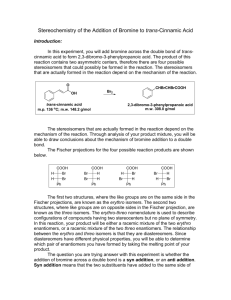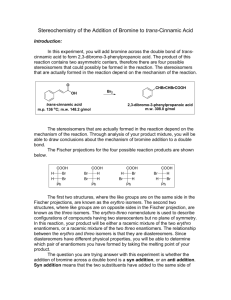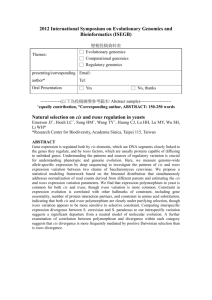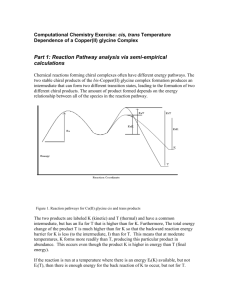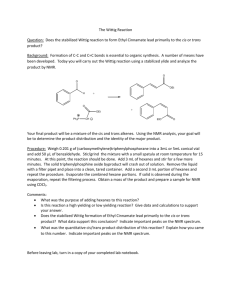Mnemonic_use_for_aiding_students_to_determine_
advertisement
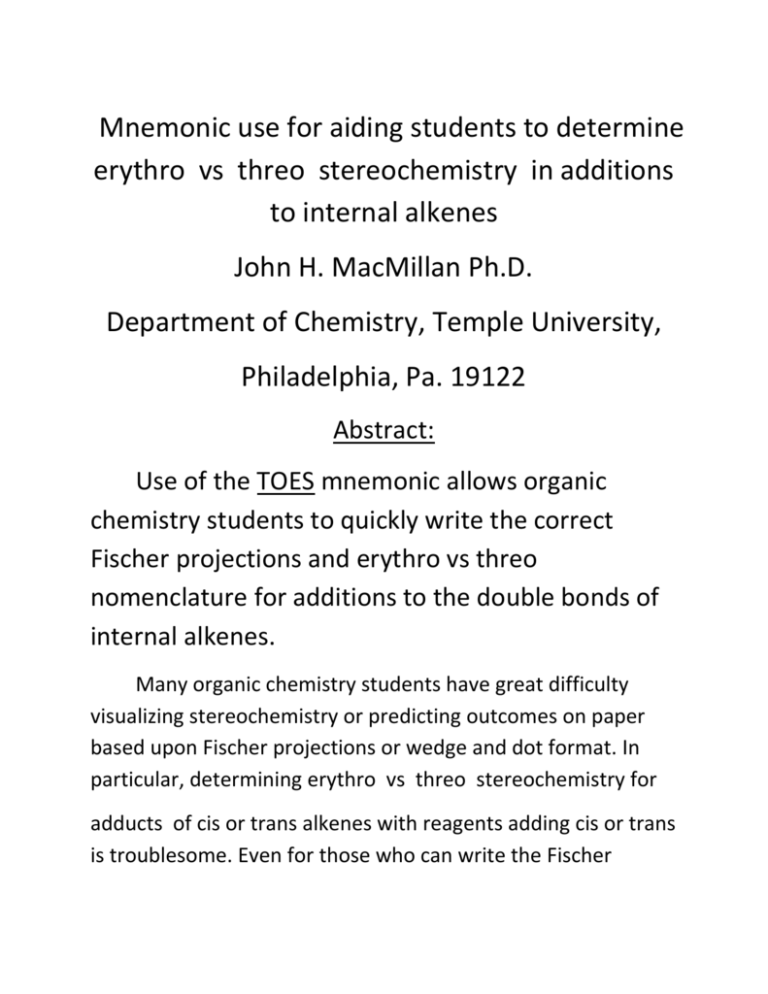
Mnemonic use for aiding students to determine erythro vs threo stereochemistry in additions to internal alkenes John H. MacMillan Ph.D. Department of Chemistry, Temple University, Philadelphia, Pa. 19122 Abstract: Use of the TOES mnemonic allows organic chemistry students to quickly write the correct Fischer projections and erythro vs threo nomenclature for additions to the double bonds of internal alkenes. Many organic chemistry students have great difficulty visualizing stereochemistry or predicting outcomes on paper based upon Fischer projections or wedge and dot format. In particular, determining erythro vs threo stereochemistry for adducts of cis or trans alkenes with reagents adding cis or trans is troublesome. Even for those who can write the Fischer projection correctly, many are confused as to whether it represents erythro or threo. I have found that use of the TOES minemonic clears the confusion and always gives correct answers both for Fischer projections and erythro vs threo nomenclature. Students easily remember TOES. Just think “what is on your feet besides shoes and socks”, or “what are at the front of your feet”? In this mneomic, T = opposite, where T represents three parameters 1, configuration of the alkene versus mode of addition, 2, orientation of the added group in the resulting Fischer projection, and 3, threo. For example, trans cinnamic acid adds 2 OH groups cis on reaction with osmium tetroxide., which is opposite, and the resulting two Fischer projection have the two OH groups opposite, and the nomenclature is threo. In this mneomic, E = same. For example, trans cinnamic acid adds bromine trans, which is the same, and the resulting two Fischer projections have the two Br groups on the same side, and the nomenclature is erythro. See the example below for trans cinnamic acid adding trans with bromine (same), yielding dibromide enantiomers on the same side with erythro nomenclature If the alkene has two identical groups on the double bond and the mode of addition is the same as the alkene configuration, the mnemonic predicts e rythro nomenclature, with both adding groups on same side in the Fischer projection. While technically correct, the student has learned that enantiomers with an internal plane of symmetry are actually a single MESO form. See the reaction below giving MESO dibromostilbene from trans bromination of trans stilbene with pyridinium bromide perbromide. Table-1 lists all possible combinations using this mnemonic. TABLE 1 THINK OF THE "TOES" ON YOUR FEET T = OPPOSITE E = SAME ALKENE ALKENE STEREOCHEM TOES RESULT FISCHER PROJECTION STEREOCHEM TYPE OF ADDITION 1) CIS SYMMETRICAL CIS SAME MESO COMPOUND INTERNAL PLANE OF SYMMETRY (ERYTHRO) 2)CIS SYMMETRICAL TRANS OPPOSITE THREO ENANTIOMERS H OPPOSITE SIDES ON FISCHER 3))TRANS SYMMETRICAL CIS OPPOSITE THREO ENANTIOMERS H OPPOSITE SIDES ON FISCHER 4)TRANS SYMMETRICAL TRANS SAME MESO COMPOUND INTERNAL PLANE OF SYMMETRY (ERYTHRO) 5)CIS UNSYMMETRICAL CIS SAME ERYTHRO ENANTIOMERS H SAME SIDES ON FISCHER 6)CIS UNSYMMETRICAL TRANS OPPOSITE THREO ENANTIOMERS H OPPOSITE SIDES ON FISCHER 7)TRANS UNSYMMETRICAL CIS OPPOSITE THREO ENANTIOMERS H OPPOSITE SIDES ON FISCHER 8)TRANS UNSYMMETRICAL TRANS SAME ERYTHRO ENANTIOMERS H SAME SIDES ON FISCHER Table-11 lists the TOES result for modes 1-8 above and a reaction illustrating each mode. TABLE-11 MODE "TOES" EXAMPLES 1 SAME CIS STILBENE WITH DEUTERIUM 2 OPPOSITE CIS STILBENE WITH BROMINE 3 OPPOSITE TRANS STILBENE WITH OsO4 4 SAME TRANS STILBENE WITH BROMINE 5 SAME CIS CINNAMIC ACID WITH OsO4 6 OPPOSITE CIS CINNAMIC ACID WITH BROMINE 7 OPPOSITE 8 SAME TRANS CINNAMIC ACID WITH DEUTERIUM TRANS CINNAMIC ACID WITH BROMINE References: 1) John McMurry, "Organic Chemistry, 7th Edition", Brooks-Cole Publishing Co., 2007. 2) Paula Bruice, "Organic Chemistry, 5th Edition", Prentice Hall., 2007.
